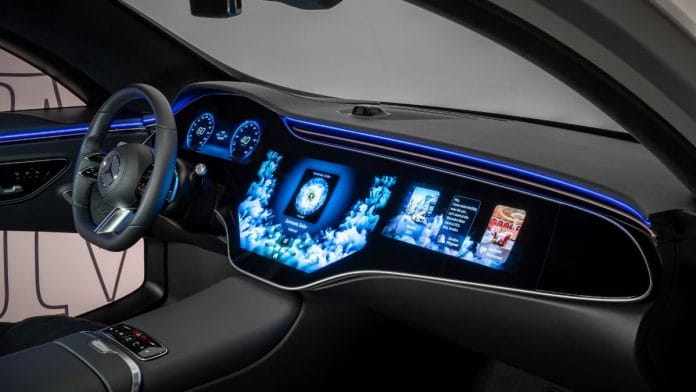While driving back home one evening, I noticed the interior lights on the Kia Sonet I was driving were rapidly changing colours. I wasn’t sure if my imagination was playing tricks on me. Then I remembered that the Kia Sonet has a feature called ‘Dancing Lights,’ where the ambient lights inside the car change colour according to the music.
And it’s not just the Sonet; interior ambient lighting has become quite a prominent feature on so many other cars. Take the Mini, for example; one can cycle through multiple colours using a toggle switch located above their head. And it’s not just the interior; just like features like Daytime Running Lights (DRLs) on modern cars, these are quickly becoming a signature element for manufacturers. BMW has always had the ‘Corona’ lights, a ring around the main headlight, but now even mass-market vehicles have such distinctive features. Cars sold under Maruti-Suzuki’s Nexa brand have three distinctive ‘dots’ on each headlight.
One of the vehicle manufacturers that I feel has truly set the standards when it comes to interior and exterior light features is the German carmaker Mercedes-Benz. They were one of the earliest automakers to experiment with Light-Emitting Diode (LED) technology.
It seems almost strange to think that we lived in a time before LEDs; they are ubiquitous nowadays, from the television to the air conditioner. At night, the lights in the bedroom seem like a whole twinkling universe, flashing on the Wi-Fi router or the smartwatch. Shuji Nakamura, the Japanese-American inventor who cracked the elusive ‘blue light’ LED that made multi-colour and, crucially, white LEDs possible, was awarded the Nobel Prize for Physics in 2014. This was one of those singular inventions that form a cornerstone of our technology-obsessed society today.
One of the first vehicles that I remember played around with LED DRLs was the Mercedes-Benz E-Class from over a decade ago. The sort of double ‘eyelash’ DRLs really made the vehicle stand out. Today, when I sit inside any Mercedes-Benz, it’s not the driving performance that captivates me; after all, when you’re stuck trying to cross the ITO traffic signal during the evening rush hour, hundreds of horsepower doesn’t help. But the dancing multicolour animated lights can help while away the time.
I wrote to Mercedes-Benz about lighting technology and received responses from Robert Lesnik, head of exterior design, and Hartmut Sinkwitz, head of interior design. From their responses, it became clear that both exterior and interior lighting are now critical elements of the design process. “Lighting design is an integrative part of the overall design process right from the start. Paying attention to the details is no less important than defining the overall proportion of our cars. With new technologies, we designers have new opportunities to showcase the tech. It’s about emotion and intelligence – in the interior as well as the exterior. While creating an appealing automotive interior, we simultaneously consider how it looks in terms of interior lighting. In terms of the exterior lighting, our Digital-Light offers the customer the perfect performance and experience at night. But also, the light-signet at day contributes to iconic and recognizable graphics. This must be considered from the beginning of the design process.”
At the end of the day, while cars are functional, they are deeply emotional purchases. Sure, many vehicles now have ‘light bars’ across the front (and the rear), but some carmakers like Tata Motors have made them functional as well on their latest electric vehicles, as they give an update on the charging status of the cars.
And this shift has been incredibly rapid. Just a few years ago, it seemed like cars had tungsten headlights, and now every car has some form of LED technology on exterior lights and increasingly interior lights as well. And it’s fascinating even for someone who has roamed around South Mumbai in a Premier Padmini taxi with a bright blue cabin light. Now you can get those Bollywood vibes on virtually any car. But isn’t this all distracting?
“Driver distraction is a serious topic, and we at Mercedes-Benz take it very seriously,” they replied to me. Having driven modern Mercedes, I know that they start a bonging alarm (and display an image of a coffee cup on the instrument cluster) if you’re distracted, as they use a small camera to track your eyes. These eye-trackers will become increasingly common on cars, but that’s a topic for a future column.
And what does the future hold for light technology? Again, Mercedes’ designers replied, “Future interior lighting is about creating a holistic experience. It will be dynamic, seamlessly integrated into the interior components, and synchronized with all the other visual and auditory effects in the car. Speaking of exterior lighting, our current electric cars feature the illumination of the band between the head- and rear lights, and the new E-Class pronounces the grill contour at night. This shows the potential and the way we are heading in terms of exterior lighting. The latest ‘Concept CLA Class,’ for example, features the star pattern illumination of the grill panel and introduces the iconic light signature in the front and the rear.”
@kushanmitra is an automotive journalist based in New Delhi. He is one of the jury members on the ICOTY panel. Views are personal.
(Edited by Prashant)






